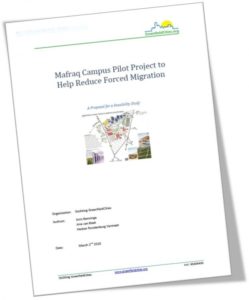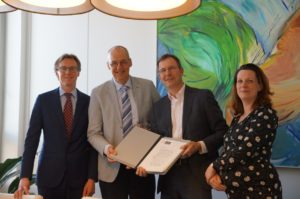After a year playing a key role in the Regional Energy Strategy (RES) Achterhoek as project manager Electricity, Climate Mitigation and Change Management’s director has been asked to take over the programme management for the RES Achterhoek as well. Tasks include:
- Draft the progress report (due summer 2023): it will answer the key question: is the region on course for realising its target in the year 2030.
- Integral programming of the target of 1.35 TWh renewable energy, notably wind power and solar power. Basically, the programme will outline what type and size of project will be realised when and where.
- Draft the end report for the Regional Energy Strategy 2.0
Congestion of the current electrical infrastructure is predominant in large parts of the Netherlands and that is also true for the Achterhoek. At the same, time Liander and TenneT are working hard on expansion of the capacity of the power grid. The expansion in power terms is in absolute terms substantial, in light of the necessary growth of renewable energy power, it is clear grid resources are only sufficient if an efficient approach of programming power is taken.
 Because of the huge difference in full load hours between wind (3500 h) and solar power (1000 h), one can win 3.5 times higher renewable energy or CO2 reduction gains with wind power as with solar power with the same investment in infrastructure. Complementary patterns of the two sources during day and over the seasons makes a ratio of 1 to 1 in power to be seen as system efficient.
Because of the huge difference in full load hours between wind (3500 h) and solar power (1000 h), one can win 3.5 times higher renewable energy or CO2 reduction gains with wind power as with solar power with the same investment in infrastructure. Complementary patterns of the two sources during day and over the seasons makes a ratio of 1 to 1 in power to be seen as system efficient.
In energy terms the energy mix of wind/solar should be 3.5 to 1. Nationally, the trend is that solar power grows faster than wind power. Keeping this ratio in check will be one of the challenges for the region Achterhoek.


 means of large scale solar and wind power (35 TWh in total). The approach is unique for the Netherlands: top-down in methodology and overall target setting and bottom-up where which renewable energy contributions can be implemented. It is believed this approach will lead to a substantial (and much needed) acceleration of the growth of renewable energy in the Netherlands.
means of large scale solar and wind power (35 TWh in total). The approach is unique for the Netherlands: top-down in methodology and overall target setting and bottom-up where which renewable energy contributions can be implemented. It is believed this approach will lead to a substantial (and much needed) acceleration of the growth of renewable energy in the Netherlands.
 On 19 February 2016 Arie van Beek and his partner Joris Benninga, legally founded an organisation on 19 February 2016 to create sustainable safe havens in the Middle East: GreenfieldCities.org. The flow of refugees from war torn Syria seems to be at an all time high. Additional steady flows from Africa keep coming in where climate change effects are hitting hard on every day’s reality. It cannot be expected these flows will go back to a trickle in the future. With GreenfieldCities.org we want to set out a path to create sustainable cities in the Middle East with the refugees as its citizens.
On 19 February 2016 Arie van Beek and his partner Joris Benninga, legally founded an organisation on 19 February 2016 to create sustainable safe havens in the Middle East: GreenfieldCities.org. The flow of refugees from war torn Syria seems to be at an all time high. Additional steady flows from Africa keep coming in where climate change effects are hitting hard on every day’s reality. It cannot be expected these flows will go back to a trickle in the future. With GreenfieldCities.org we want to set out a path to create sustainable cities in the Middle East with the refugees as its citizens.  For the first time sustainability including climate change mitigation and transformation to a sustainable energy supply has been fully fledged incorporated in the guidelines for an Environmental Impact Assessment (EIA) for a spatial plan published by the Netherlands Commission for Environmental Assessment. The spatial plan covers a region in the North of the Netherlands (Eemsmond) and includes two big sea harbours, 1 city and several villages, several big fossil fuelled power plants and wind farms. So far, only effects of and mitigation measures for harmful emissions having clear legal thresholds were included in the Commission’s guidelines. Deducing a threshold concentration for CO2 from the widely accepted 2 degrees warming maximum the case was made to include CO2 emissions (and its mitigation) in the EIA for the Regional Spatial plan for the Eemsmond (“Structuurvisie Eemsmond-Delfzijl”).
For the first time sustainability including climate change mitigation and transformation to a sustainable energy supply has been fully fledged incorporated in the guidelines for an Environmental Impact Assessment (EIA) for a spatial plan published by the Netherlands Commission for Environmental Assessment. The spatial plan covers a region in the North of the Netherlands (Eemsmond) and includes two big sea harbours, 1 city and several villages, several big fossil fuelled power plants and wind farms. So far, only effects of and mitigation measures for harmful emissions having clear legal thresholds were included in the Commission’s guidelines. Deducing a threshold concentration for CO2 from the widely accepted 2 degrees warming maximum the case was made to include CO2 emissions (and its mitigation) in the EIA for the Regional Spatial plan for the Eemsmond (“Structuurvisie Eemsmond-Delfzijl”).